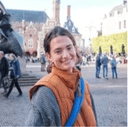Artificial Intelligence and patterns of influence in the arts and entertainment industries (2023- 2027)
Start Date: 2023
Team Members: Teresa Liberatore, Monika Kackovic, Nachoem Wijnberg
Artificial Intelligence and patterns of influence in the arts and entertainment industries (2023- 2027). Teresa Liberatore (PhD candidate) – supervisory team: Monika Kackovic (FEB), Paul Groth (FNWI), Nachoem Wijnberg (FEB).
The arts and entertainment sectors, part of the creative and cultural industries, are characterized by a complex web of patterns of influence. These influence patterns can take many forms, such as the transfer of ideas and techniques between different (artistic) disciplines, the adoption of (aesthetic) styles and trends by different artists and organizations, and the flow of resources and funding between different sectors. One of the key ways in which influence operates is through the fashioning, dissemination, and adoption of creative ideas. This means that influence relations are often characterized by a high degree of cross-pollination, with ideas and trends flowing freely between different sectors or disciplines. By examining the influence patterns between different cultural and creative disciplines – the data can take the form of text, static images, and/or video – we can better understand the mechanisms that drive the flow of ideas and techniques across diverse domains and identify the (key) drivers of innovation within and across sectors. For instance, directors and writers in the movie/TV industry may borrow elements from other films, art, or books to create new and original stories. Similarly, in the music industry, artists and musicians may draw inspiration from a wide range of sources, including other genres of music, art forms, and even technology. Blending different styles and influences can create new and innovative works and/or expand upon existing artistic traditions. Overall, the patterns of influence within the arts and entertainment industries are intricate, with new trends and styles emerging all the time. By studying these influence patterns, we can understand the factors that drive innovation and success within these industries, which may provide greater insights into how these factors can be harnessed to support entrepreneurship and growth. In addition, studying the influence relations can also shed light on the broader sociocultural forces that shape these industries, such as the role of entrepreneurs, cultural institutions, and commercial enterprises, the impact of technological innovation, and the influence of global trends and market forces.
This interdisciplinary project aims to better understand the factors that can explain innovation and entrepreneurial projects’ success (and failures) by applying advanced computational machine learning approaches.
The team

Teresa Liberatore
PhD Candidate

Monika Kackovic
Lab Director & Associate professor of Entrepreneurship and Innovation

Nachoem Wijnberg
Professor